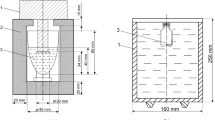Abstract
Effects of oil refining steps (degumming, neutralizing, bleaching, and deodorizing) on rheological properties of catfish oil were investigated. Four rheological models (Newtonian, Bingham, Herschel-Bulkley, and Casson) were used to fit the experimental data. Refined catfish oil behaves like a Newtonian fluid. Based on the Casson model, the yield stress values of oils gradually decreased after each refining step. The highest shear rate index (0.904) was observed in the deodorized oil. The Casson model was used to predict rheological properties because it works well at both lower and higher shear rates.
Similar content being viewed by others
References
Sherman, P., Industrial Rheology with Particular Reference to Foods, Pharmaceuticals and Cosmetics, Academic Press, London, 1970.
Wiedermann, L.H., Degumming, Refining and Bleaching Soybean Oil, J. Am. Oil Chem. Soc. 58:159–66 (1981).
Weltmann, R.N., Thixotropic Behavior of Oils, Ind. Eng. Chem. 15:424–429 (1943).
Dijkstra, A., and M.V. Opstal, The Total Degumming Process, J. Am. Oil Chem. Soc. 66:1002–1009 (1989).
AOCS, Official Methods and Recommended Practices of the American Oil Chemists’ Society, 3rd edn., edited by D. Firestone, American Oil Chemists’ Society, Champaign, 1989.
Scott, K.C., and J.D. Latshaw, Effects of Commercial Processing on the Fat-Soluble Vitamin Content of Menhaden Fish Oil, J. Am. Oil Chem. Soc. 68:234–236 (1991).
Bitner, E.D., J.P. Friedrich, and T.L. Mounts, Laboratory Continuous Deodorizer for Vegetable Oils, Ibid. 63:338–340 (1986).
Casson, N., A Flow Equation for Pigmented-Oil Suspension of the Printing Ink Type, in Rheology of Disperse Systems, edited by C.C. Mill, Pergamon Press, New York, 1959, pp. 82–104.
Teeter, H.M., and J.C. Cowan, Viscometric Properties of Higher Fatty Acids and Their Derivatives, J. Am. Oil Chem. Soc. 33: 163–168 (1956).
Sathivel, S., W. Prinyawiwatkul, J.M. King, C.C. Grimm, and S. Lloyd, Oil Production from Catfish Viscera, Ibid. 80:377–382 (2003).
Lunde, G., L.H. Landmark, and J. Gether, Sequestering and Exchange of Metal Ions in Edible Oils Containing Phospholipids, Ibid. 53:207–210 (1976).
Lunde, G., Activation Analysis of Trace Elements in Lipids with Emphasis on Marine Oils, Ibid. 48:517–522 (1971).
Author information
Authors and Affiliations
Corresponding author
About this article
Cite this article
Sathivel, S., Prinyawiwatkul, W., Negulescu, I.I. et al. Effects of purification process on rheological properties of catfish oil. J Amer Oil Chem Soc 80, 829–832 (2003). https://doi.org/10.1007/s11746-003-0780-3
Received:
Accepted:
Issue Date:
DOI: https://doi.org/10.1007/s11746-003-0780-3




